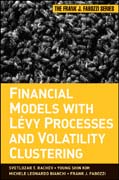
Financial models with Levy processes and volatility clustering
Rachev, Svetlozar T.
Kim, Young Shim
Bianchi, Michele L.
INDICE: 1 Introduction. 1.1 The need for better financial modeling of assetprices. 1.2 The family of stable distribution and its properties. 1.3 Option pricing with volatility clustering. 1.4 Model dependencies. 1.5 Monte Carlo. 1.6 Organization of the book. 2 Probability distributions. 2.1 Basic concepts. 2.2 Discrete probability distributions. 2.3 Continuous probability distributions. 2.4 Statistic moments and quantiles. 2.5 Characteristic function. 2.6 Joint probability distributions. 2.7 Summary. 3 Stable and tempered stable distributions. 3.1 ±-Stable distribution. 3.2 Tempered stable distributions. 3.3 Infinitely divisible distributions. 3.3.1 Exponential Moments. 3.4 Summary. 3.5 Appendix. 4 Stochastic Processes in Continuous Time. 4.1 Some preliminaries. 4.2Poisson Process. 4.3 Pure jump process. 4.4 Brownian motion. 4.5 Time-ChangedBrownian motion. 4.6 L´evy process. 4.7 Summary. 5 Conditional Expectation and Change of Measure. 5.1 Events, Ã-fields, and filtration. 5.2 Conditional expectation. 5.3 Change of measures. 5.4 Summary. 6 Exponential L´evy Models. 6.1Exponential L´evy Models. 6.2 Fitting ±-stable and tempered stable distributions. 6.3 Illustration: Parameter estimation for tempered stable distributions.6.4 Summary. 6.5 Appendix : Numerical approximation of probability density and cumulative distribution functions. 7 Option Pricing in Exponential L´evy Models. 7.1 Option contract. 7.2 Boundary conditions for the price of an option. 7.3 No-arbitrage pricing and equivalent martingale measure. 7.4 Option pricingunder the Black-Scholes model. 7.5 European option pricing under exponential tempered stable Models. 7.6 The subordinated stock price model. 7.7 Summary. 8Simulation. 8.1 Random number generators. 8.2 Simulation techniques for L´evyprocesses. 8.3 Tempered stable processes. 8.4 Tempered infinitely divisible processes. 8.5 Time-changed Brownian motion. 8.6 Monte Carlo methods. Appendix.9 Multi-tail t distribution. 9.1 Introduction. 9.2 Principal component analysis. 9.3 Estimating parameters. 9.4 Empirical results. 9.5 Conclusion. 10 Non-Gaussian portfolio allocation. 10.1 Introduction. 10.2 Multi-factor linear model. 10.3 Modeling dependencies. 10.4 Average value-at-risk. 10.5 Optimal portfolios. 10.6 The algorithm. 10.7 An empirical test. 10.8 Conclusions. 11 Normal GARCH models. 11.1 Introduction. 11.2 GARCH dynamics with normal innovation. 11.3 Market estimation. 11.4 Risk-neutral estimation. 11.5 Conclusions. 12 Smoothly truncated stable GARCH models. 12.1 Introduction. 12.2 A Generalized NGARCH Option Pricing Model. 12.3 Empirical Analysis. 12.4 Conclusion. 13 Infinitely divisible GARCH models. 13.1 Stock price dynamic. 13.2 Risk-neutral dynamic. 13.3 Non-normal infinitely divisible GARCH. 13.4 Simulate infinitely divisible GARCH. Appendix. 14
- ISBN: 978-0-470-48235-3
- Editorial: John Wiley & Sons
- Encuadernacion: Cartoné
- Páginas: 416
- Fecha Publicación: 19/01/2011
- Nº Volúmenes: 1
- Idioma: Inglés
